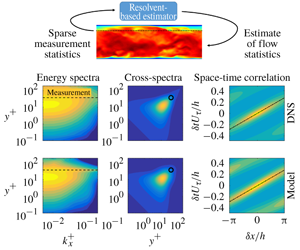Crossref Citations
This article has been cited by the following publications. This list is generated based on data provided by
Crossref.
Symon, Sean
Sipp, Denis
and
McKeon, Beverley J.
2019.
A tale of two airfoils: resolvent-based modelling of an oscillator versus an amplifier from an experimental mean.
Journal of Fluid Mechanics,
Vol. 881,
Issue. ,
p.
51.
Martini, Eduardo
Cavalieri, André V. G.
Jordan, Peter
Towne, Aaron
and
Lesshafft, Lutz
2020.
Resolvent-based optimal estimation of transitional and turbulent flows.
Journal of Fluid Mechanics,
Vol. 900,
Issue. ,
Pickering, Ethan M.
Towne, Aaron
Jordan, Peter
and
Colonius, Tim
2020.
Resolvent-based jet noise models: a projection approach.
Hwang, Yongyun
and
Eckhardt, Bruno
2020.
Attached eddy model revisited using a minimal quasi-linear approximation.
Journal of Fluid Mechanics,
Vol. 894,
Issue. ,
Vamsi Krishna, C.
Wang, Mengying
Hemati, Maziar S.
and
Luhar, Mitul
2020.
Reconstructing the time evolution of wall-bounded turbulent flows from non-time-resolved PIV measurements.
Physical Review Fluids,
Vol. 5,
Issue. 5,
Yang, Bowen
Jin, Guodong
Wu, Ting
Yang, Zixuan
and
He, Guowei
2020.
Numerical implementation and evaluation of resolvent-based estimation for space–time energy spectra in turbulent channel flows.
Acta Mechanica Sinica,
Vol. 36,
Issue. 4,
p.
775.
Zare, A.
Georgiou, T.T.
and
Jovanović, M.R.
2020.
Stochastic Dynamical Modeling of Turbulent Flows.
Annual Review of Control, Robotics, and Autonomous Systems,
Vol. 3,
Issue. 1,
p.
195.
Abreu, Leandra I.
Cavalieri, André V. G.
Schlatter, Philipp
Vinuesa, Ricardo
and
Henningson, Dan S.
2020.
Spectral proper orthogonal decomposition and resolvent analysis of near-wall coherent structures in turbulent pipe flows.
Journal of Fluid Mechanics,
Vol. 900,
Issue. ,
Bae, H. Jane
Dawson, Scott T. M.
and
McKeon, Beverley J.
2020.
Resolvent-based study of compressibility effects on supersonic turbulent boundary layers.
Journal of Fluid Mechanics,
Vol. 883,
Issue. ,
McMullen, Ryan M.
Rosenberg, Kevin
and
McKeon, Beverley J.
2020.
Interaction of forced Orr-Sommerfeld and Squire modes in a low-order representation of turbulent channel flow.
Physical Review Fluids,
Vol. 5,
Issue. 8,
Tissot, Gilles
Cavalieri, André V. G.
and
Mémin, Étienne
2021.
Stochastic linear modes in a turbulent channel flow.
Journal of Fluid Mechanics,
Vol. 912,
Issue. ,
Chen, Zhibo
and
Towne, Aaron
2021.
An azimuthal Fourier domain formulation of the Ffowcs Williams and Hawkings equation.
The Journal of the Acoustical Society of America,
Vol. 150,
Issue. 3,
p.
1967.
Towne, Aaron
2021.
Space-time Galerkin projection via spectral proper orthogonal decomposition and resolvent modes.
Jovanović, Mihailo R.
2021.
From Bypass Transition to Flow Control and Data-Driven Turbulence Modeling: An Input–Output Viewpoint.
Annual Review of Fluid Mechanics,
Vol. 53,
Issue. 1,
p.
311.
Ahmed, M. A.
Bae, H. J.
Thompson, A. F.
and
McKeon, B. J.
2021.
Resolvent analysis of stratification effects on wall-bounded shear flows.
Physical Review Fluids,
Vol. 6,
Issue. 8,
Lozano-Durán, Adrián
Constantinou, Navid C.
Nikolaidis, Marios-Andreas
and
Karp, Michael
2021.
Cause-and-effect of linear mechanisms sustaining wall turbulence.
Journal of Fluid Mechanics,
Vol. 914,
Issue. ,
Wu, Ting
and
He, Guowei
2021.
Space-time energy spectra in turbulent shear flows.
Physical Review Fluids,
Vol. 6,
Issue. 10,
Shinde, Vilas J.
and
Gaitonde, Datta
2021.
Galerkin-POD Reduced-Order Modeling for Perturbation Analysis and Sparse State Estimation of Compressible Flows.
Martini, Eduardo
Rodríguez, Daniel
Towne, Aaron
and
Cavalieri, André V.G.
2021.
Efficient computation of global resolvent modes.
Journal of Fluid Mechanics,
Vol. 919,
Issue. ,
Wang, Mengying
Krishna, C. Vamsi
Luhar, Mitul
and
Hemati, Maziar S.
2021.
Model-based multi-sensor fusion for reconstructing wall-bounded turbulence.
Theoretical and Computational Fluid Dynamics,
Vol. 35,
Issue. 5,
p.
683.


